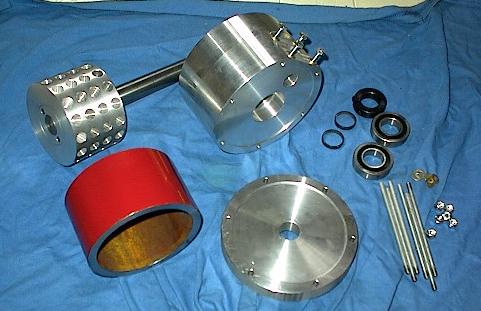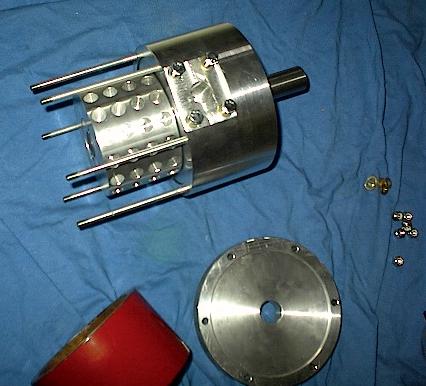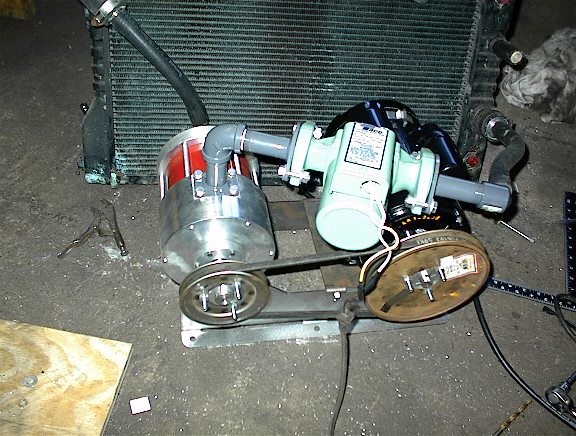I've been looking into alternatives to heating water as well as adding a bit of heat to my house. I ran accross the ole Griggs patent (1993) and it's simplicity caught my eye. Basically I want to drive it with wind but in the test platform I'm using a 2hp compressor motor. Below is a picture of the parts machined and just before assembly...<p>

<p>
It's a small version of patent, sporting a 4 inch rotor with 60 1/2" holes drilled 3/4" deep to create the cavitation. Although its called a hydrosonic pump it really doesn't "pump" and I added a small Taco circulator to move the water around. Below is a picture of the pump partially assembled...<p>

<p>
After assembling the pump unit I was pretty head strong about getting it together for some testing so I cobbled together some adaptors to fit an old S10 radiator and plumbed it together with anything I could find that would work...<p>

<p>
My initial tests were pretty impressive for such a small unit. The water temp was 69 degrees(F), I fired it up and had my hand on the pump and instantly could feel the change. It was at 80 degrees in the first min and within 15 minutes was sitting on 172 degrees. After which I turned it off because I was having problems with my breaker because of the long extention cord ( which was also getting hot ). It averaged 7 degrees per min rise in temp and there is a gallon and a half in the system ( about 12 lbs of water ). A little over 5000BTU per hour. It was pulling 1800 watts according to the watt meter or about 81% efficient through the conversion. <p>
I found a newer patent a couple nights ago (1999) and found there are some things that could make it a bit more efficient. All my holes are bored straight on center and some of the others are boring them at 15 degrees toward rotation. I'll be making up another rotor for the unit with all the updated modifications this weekend. <p>
I've read some claims of 130 to 170% on thier units although I'm a bit skeptical on that account. I'd be quite happy with a 90% conversion for my project. <p>
Lots of fun as always! I spent about 30+ hours of pure enjoyment building it and I have a larger one in the plans...
I have some question and i hope you answer me soon.
1. If we want to make steam 90°C continuously, how many Kwh would it consumes per day in order to make full time
90°C steam ?
2. How many BTU/day could it generate in order to make full time 90°C steam ?
3. How much cost the entire machine, if you would like to sell it?
4. Cavitation damages his environmental equipments in all pumps because of high pressure and highly temprature in the around of bubbles, why it does not damages your hydrosonic pump?
Sorry for my language skills, I hope you understands what i mean. I will thank you if you answer my question here and/or rather the following email, because i check it every day. This is my E-mail: hamidrezataheri135@gmail.com
Have a nice day and good luck.